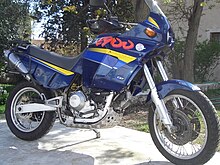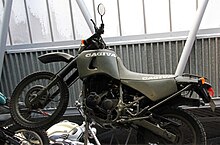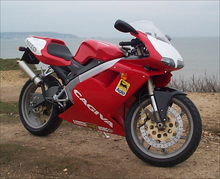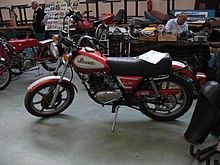Cagiva
This article needs additional citations for verification. (August 2019) |
45°48′13″N 8°46′42″E / 45.8035942°N 8.7782452°E
1978 Cagiva wordmark | |
| Company type | Subsidiary |
|---|---|
| Industry | Motorcycle manufacturing |
| Predecessor | Aermacchi Harley-Davidson |
| Founded | 1950 (Motorcycle: 1978) |
| Founder | Giovanni Castiglioni |
| Defunct | 2008 |
| Fate | Merged in MV Agusta |
| Headquarters | , Italy |
Area served | Worldwide |
Key people | Claudio and Gianfranco Castiglioni |
| Products | Motorcycle |
| Parent | MV Agusta |
| Subsidiaries | Ducati (1985 - 1996) Moto Morini (1987 - 1996) Husqvarna Motorcycles (1987 - 2007) |
| Website | www.cagiva.it |
| Footnotes / references slogan: «La moto italiana». | |
Cagiva is an Italian motorcycle manufacturer. It was founded in 1950 by Giovanni Castiglioni in Varese, originally producing small metal components. Giovanni's sons, Claudio and Gianfranco Castiglioni, went into the motorcycle industry in 1978. The name is a portmanteau derived from the founder's name 'Giovanni Castiglioni' and the founding location, i.e. Castiglioni Giovanni Varese.
In its history, Cagiva won races in Dakar and Motocross competitions, as well as in Grand Prix motorcycle racing.
History
[edit]
In 1978, Cagiva entered the motorcycle business with two racing motorcycles ridden by Gianfranco Bonera and Marco Lucchinelli. In the same year it bought a factory in Varese's frazione of Schiranna from Aermacchi/AMF-Harley-Davidson and went into motorcycle production. By 1979 the company reached an annual production of 40,000 motorbikes, with eight models powered by two-stroke engines ranging from 125 cc to 350 cc.
Many of the Harley-Davidson models were continued in production as Cagivas, and the off-road motorcycle division was improved and expanded, eventually producing its own race-winning WMX series of motocross motorcycles.


In 1983 Cagiva also sourced Ducati four stroke v-twin engines from 350 cc to 1000 cc and entered the big displacement market. Cagiva bought Ducati in 1985, but kept the Ducati brand that was better recognized outside Italy. Ducati motorcycle production continued in Bologna, while the Varese-built Cagiva Ala Azzurra (sold under the name "Alazzurra", "Bluewing") and Elefant were introduced, both featuring Ducati engines.[2]
Cagiva continued with strategic buyouts of Moto Morini and Husqvarna in 1987. In 1991 Cagiva also bought the trademarks for the MV Agusta brand.
In 1996, Cagiva accepted the offer by the Texas Pacific Group and sold the Ducati and Moto Morini brands. In 1999 Cagiva Group was restructured for strategic purposes, with MV Agusta becoming the parent company and main brand identity; Cagiva along with Husqvarna thus became MV Agusta's subsidiaries.[3]
In 2000, production of the Cagiva Roadster ended. In 2008, Harley-Davidson bought MV Agusta Motor, the parent company of Cagiva, thereby regaining some control of its old Aermacchi factory.
In October 2009, Harley-Davidson informed that it would put Cagiva up for sale. In the August of the following year, Cagiva was bought back by the son of the founder and former owner Claudio Castiglioni.
In 2012, production of new high engine capacity Mitos ended. Increasingly stringent environmental emission requirements and the concentration of resources on MV Agusta's F3 were cited as reasons. The last few Mito SP525s produced were white in colour, and personally signed by MV Agusta CEO Giovanni Castiglioni, thus ended the legacy of the Mito, alongside the end of the Raptors.
Racing
[edit]In the early 1980s, Cagiva began to manufacture dirt bikes and started a massive public relations program with the opening of its North American branch. It hired Ron Turner and Duane Summers to test and develop its bikes. Cagiva motocross bikes were characterized by their fast powerful engines and innovative features, such as the MX line that had only one spring in the front forks with one fork controlling rebound and the other compression.
500cc World Championship
[edit]
At the end of the 1970s the company began campaigning the Grand Prix motorcycle racing circuit. Randy Mamola was its lead rider from 1988 to 1990, and he achieved Cagiva's first podium result. It would also have some technical assistance from Yamaha. In 1991 it signed former world champion Eddie Lawson to its team. Lawson would claim the company's first victory when he won the 1992 Hungarian Grand Prix. John Kocinski would also win a Grand Prix on a Cagiva GP500 (C594), finishing third in the 1994 world championship.
Dakar Rally
[edit]
In 1990 and 1994 the Italian rider Edi Orioli won the Dakar Rally on the Ducati-powered Cagiva Elefant.
| Year | Champion | Motorcycle |
|---|---|---|
| 1990 | Elefant 944 Lucky Explorer | |
| 1994 | Elefant 944 Marathon |
Motocross World Championship
[edit]- 125 cc class
| Year | Champion | Motorcycle |
|---|---|---|
| 1985 | Cagiva WMX | |
| 1986 | Cagiva WMX |
Motocross World World Constructors champions
[edit]- 125 cc class
- 1985, 1986, 1987

Italian Speed championship
[edit]| Year | Champion | Class | Motorcycle |
|---|---|---|---|
| 1990 | Open | ||
| 1991 | Open | ||
| 1992 | Open | ||
| 1994 | Supermono |
Mini Moke
[edit]Cagiva bought BMCs design for the Mini Moke, manufacturing them in Portugal using British built engines from 1990 until 1993. Intending to transfer production to the Bologna factory early in 1995, the tooling for the Moke was transferred to Italy late in 1993, but production never restarted.
Models
[edit]Racing motorcycles
[edit]| Model | Engine | Years | Notes | Image |
|---|---|---|---|---|
| HD Cagiva RR250 [4] | (1979) | |||
| Suzuki/Cagiva 500 GP [5] | (1979) | |||
| 1C2[6] | (1980) | |||
| 2C2[7] | (1981) | |||
| 3C2[8] | (1982) | |||
| 4C3 [9] | (1983) |  | ||
| C9[10] | (1984) | |||
| C10[11] | (1985–1986–1987) |  | ||
| C587 | (1987) | |||
| 125 GP[12] | (1988) | |||
| C588 | (1988) | |||
| C589 | (1989) |  | ||
| C590 | (1990) | |||
| C591 | (1991) |  | ||
| C592 | (1992) | |||
| C593 | (1993) |  | ||
| C594 | (1994) |  | ||
| F4 | (1995–1996) | prototype, Ferrari engine |  | |
| Mito Mk II SP | () | The first bike of Valentino Rossi |  | |
| Elefant 750 Elf-Ligier [13][14] | 748,1 cc, 90° L-twin, 4-stroke engine, SOHC, desmodromic 2-valves, air-cooled-Oil cooling | (1985) | Ducati Pantah engine. Cagiva team to Dakar 1985: Hubert Auriol, Giampaolo Marinoni and Gilles Picard | |
| Elefant 850 Lucky Explorer [15][16] | cc, 90° L-twin, 4-stroke engine, SOHC, desmodromic 2-valves, air-cooled-Oil cooling | (1986–1987) | Ducati engine. Cagiva team to Dakar 1987: Hubert Auriol, Alessandro De Petri, Gilles Picard and Franco Gualdi. | |
| Elefant 900 Lucky Explorer | cc, 90° L-twin, 4-stroke engine, SOHC, desmodromic 2-valves, air-cooled-Oil cooling | (1988–1989) | Ducati engine. Cagiva team to Dakar 1988: Serge Bacou, Alessandro De Petri, Gilles Picard and Franco Gualdi. Cagiva team to Dakar 1989: Edi Orioli, Alessandro De Petri, Gilles Picard and Claudio Terruzzi. | |
| Elefant 944 Lucky Explorer | 943,8 cc, 90° L-twin, 4-stroke engine, SOHC, desmodromic 2-valves, air-cooled-Oil cooling[17] | (1990–1991) | Ducati engine. Cagiva team to Dakar 1990: Edi Orioli, Alessandro De Petri and Jordi Arcarons. | |
| Elefant 904 Lucky Explorer | cc, 90° L-twin, 4-stroke engine, SOHC, desmodromic 2-valves, air-cooled-Oil cooling | (1992) | Ducati engine. Cagiva team to Paris–Cape Town 1992: Danny Laporte, Jordi Arcarons, Marc Morales, Edi Orioli and Davide Trolli. | |
| Elefant 944 Marathon [18] | cc, 90° L-twin, 4-stroke engine, SOHC, desmodromic 2-valves, air-cooled-Oil cooling | (1994-1995-1996-1997) | Ducati engine |
Road
[edit]Off road - enduro - trial
[edit]Adventure - dual sport
[edit]| Model | Engine | Years | Notes | Image |
|---|---|---|---|---|
| SXT 125 | 124,63 cc, Single, Two-stroke engine, Reed valve, Air-cooled engine | (1975–1983) |  | |
| SXT 175 | , Single, Two-stroke engine, Reed valve, Air-cooled engine | () | ||
| SXT 250 | 243 cc, Single, Two-stroke engine, Reed valve, Air-cooled engine | (1975–1985) | ||
| SXT 350 | 342,00 cc, Single, Two-stroke engine, Reed valve, Air-cooled engine | (1978–1984) | ||
| Ala Blu 125 | 124,63 cc, Single, Two-stroke engine, Reed valve, Air-cooled engine | (1983–1985) | ||
| Ala Blu 250 | , Single, Two-stroke engine, Reed valve, Air-cooled engine | (1983–1985) | ||
| Ala Blu 350 | 342,00 cc, Single, Two-stroke engine, Reed valve, Air-cooled engine | (1983–1985) | ||
| Aletta Rossa 125 | 124,63 cc, Single, Two-stroke engine, Reed valve, liquid cooling | (1983–1987) |  | |
| Aletta Rossa 200 | 190,38 cc, Single, Two-stroke engine, Reed valve, liquid cooling | (1984–1986) | ||
| Ala Rossa 350 | 343 cc, Single, 4-stroke engine, SOHC, 2-valves, Air-cooled engine | (1983–1988) | ||
| Elefant 125 Elefant2 125 Elefant3 125 |
124,63 cc, Single, Two-stroke engine, Reed valve, liquid cooling | (1984–1990) | ||
| Elefant 200 | 190,38 cc, Single, Two-stroke engine, Reed valve, liquid cooling | () | ||
| Elefant 350 Elefant 350 Big Belly |
349 cc, 90° V-twin, 4-stroke engine, Desmodromic valve, 2-valves, Air-cooled engine | (1985–1989) | Ducati engine | |
| Elefant 650 Elefant 650 MK2 Elefant 650 MK3 Elefant 650 L.E. Elefant 650 Frecce Tricolori Elefant 650 Ligier Export |
649,6 cc, 90° V-twin, 4-stroke engine, Desmodromic valve, 2-valves, Air-cooled engine-Oil cooling | (1985–1989) | Ducati engine |  |
| Elefant 750 Elefant 750 bifaro Elefant 750 AC Elefant 750 Marathon |
748 cc, 90° V-twin, 4-stroke engine, Desmodromic valve, 2-valves, Air-cooled engine-Oil cooling | (1987–1998) | Ducati engine |   |
| Elefant 900 i.e. Elefant 900 i.e. GT Elefant 900 AC Elefant E900 Elefant Marathon 944 Ducati E900 (North American market) |
904 cc, 90° V-twin, 4-stroke engine, Desmodromic valve, 2-valves, Air-cooled engine-Oil cooling | (1991–1997) | Ducati engine |   |
| T4 350 E / T4 350 R | 343 cc, Single, 4-stroke engine, SOHC, 4-valves, Air-cooled engine | (1987–1991) |  | |
| T4 500 E / T4 500 R | 452 cc, Single, 4-stroke engine, SOHC, 4-valves, Air-cooled engine | (1987–1991) | ||
| Canyon 500 | 498 cc, Single, 4-stroke engine, SOHC, 4-valves, Air-cooled engine-Oil cooling | (1997–2002) | ||
| Canyon 600 | 601,4 cc, Single, 4-stroke engine, SOHC, 4-valves, Air-cooled engine-Oil cooling | (1995–1998) | ||
| Gran Canyon | 904 cc, 90° V-twin, 4-stroke engine, Desmodromic valve, 2-valves, Air-cooled engine-Oil cooling | (1998–2000) | Ducati engine |  |
| W8 | 124,63 cc, Single, Two-stroke engine, Reed valve, liquid cooling | (1991–1995) | A cheaper version was subsequently produced until 1999 with an air-cooled thermal unit without an exhaust valve and the piston exclusively of the two-band type, furthermore the silencer was replaced with a painted iron model. |  |
| W12 | 343 cc, Single, 4-stroke engine, SOHC, 4-valves, Air-cooled engine | (1993–1996) |  | |
| W16 | 601,41 cc, Single, 4-stroke engine, SOHC, 4-valves, Air-cooled engine | (1994–2001) | GoldenEye - Pierce Brosnan Cagiva 600 W16 In the pre-title sequence of GoldenEye set in Russia's Arkangel facility, Bond is in trouble. He retrieves a Cagiva motorcycle from a dispatched guard and accelerates down a runway in pursuit of a pilot-less aeroplane - his only escape. |  |
| Cruiser | 124,63 cc, Single, Two-stroke engine, Reed valve, liquid cooling | (1987–1989) | Freccia C9 engine | |
| Tamanaco | 124,63 cc, Single, Two-stroke engine, Reed valve, liquid cooling | (1988–1991) | Freccia C10 engine | |
| N90 | 124,63 cc, Single, Two-stroke engine, Reed valve, liquid cooling | (1990–1991) | Mito engine | |
| Navigator 1000 | 996 cc, 90° V-twin, 4-stroke engine, DOHC, 4-valves, liquid cooling | (2000–2005) | Suzuki engine, (TL1000S) |  |
Moped and Scooter
[edit]- Cocis
- Prima 50 / Prima 75
- SuperCity 50 / SuperCity 75
- Mito 50
- W4 50 / W4 75
- Passing 50cc (Scooter)
See also
[edit]References
[edit]- ^ "Esercito: al 'Motodays' con moto storiche e l'ultima nata, la Cagiva 350 (2)". Archived from the original on 2014-03-06. Retrieved 2015-01-11.
- ^ 1985-1987 Cagiva Alazzurra Motorcycle Classics article, Jan/Feb 2008
- ^ "Cagiva Recent Facts". Cagiva. Archived from the original on 2008-02-15. Retrieved 2008-02-03.
- ^ HD CAGIVA RR250 Registro Storico Cagiva article, 2020
- ^ SUZUKI/CAGIVA 500 GP Registro Storico Cagiva article, 2020
- ^ CAGIVA 1C2 500 GP Registro Storico Cagiva article, 2020
- ^ CAGIVA 2C2 500 GP Registro Storico Cagiva article, 2020
- ^ CAGIVA 3C2 500 GP Registro Storico Cagiva article, 2020
- ^ CAGIVA 4C3 (C7) 500 gp Registro Storico Cagiva article, 2020
- ^ CAGIVA C9 500 GP Registro Storico Cagiva article, 2020
- ^ CAGIVA C10V 85 500 GP Registro Storico Cagiva article, 2020
- ^ CAGIVA 125, la casa varesina nel Motomondiale non solo nella classe 500 www.italiaonroad.it article, novembre, 2021
- ^ CAGIVA 750 ELF LIGIER " Official Proto " Registro Storico Cagiva article, 2020
- ^ Dakar 1985 | La Cagiva Elefant, 1st 750 according to Giampaolo Marinoni www.parisdakar.it article, 20 October 2020
- ^ The Cagiva Elefant of Giampaolo Marinoni www.parisdakar.it article, 4 May 2015
- ^ Cagiva Elefant 850 1987 www.parisdakar.it article, 4 May 2015
- ^ Elefant Paris–Dakar ‘90 www.cagivaelefant.it article, 2003
- ^ Cagiva elephant Marathon Dakar 1994 www.parisdakar.it article, 9 February 2017
External links
[edit]- Official website
- Cagiva Heritage - Registro Storico Cagiva
- All Cagiva motorcycles since 1978
- Cagiva in Motorcycle Grand Prix racing













